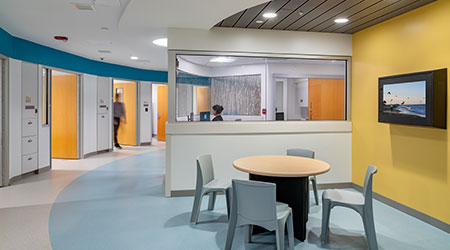The COVID-19 pandemic has shined light on several areas of healthcare, particularly behavioral health. As more people are paying attention to their mental well-being, demand is growing for behavioral health facilities. In response, healthcare systems are launching expansions and new construction of behavioral health facilities.
When planning such projects, designers must take into account appropriate furnishings and the way patients will interact with them.
“Furniture decisions can impact the safety of both staff and patients as the furniture will be used throughout the facility and can become an opportunity for injury if not properly considered,” says Brittany Page, senior interior designer with Margulies Perruzzi. “When selecting furniture for a behavioral health facility, form and function should be a concern. But remember that furniture can soften an environment and make it feel more comfortable and welcoming. Focusing on the overall atmosphere and creating a calming environment is very important when working with behavioral health populations.”
Furniture decisions in behavioral health facilities can present risks. Because these facilities tend to treat patients with social, mental and physical illnesses, it is essential that designers choose furniture that does not pose physical harm to residents or employees.
“Furniture decisions are just as important as door hardware decisions in a behavioral health facility,” Page says. “Furniture can be used as a weapon against oneself or against staff. Sometimes weighted furniture is used so it cannot be picked up and thrown. Also, the furniture should be tamper-proof so a user is not able to remove a screw and hurt themselves or someone else with it. While wood is typically durable, a wood look polymer or steel is recommended as it holds up to scrubbing and cleaners much better. Round edges on surfaces provide another level of safety.”
Different parts of the facility also require different types of furniture that will best accommodate patient needs. For example, in multipurpose areas, furniture should be reconfigurable and multifunctional. Depending on the acuity of patient population and level of supervision, furniture also can be built in or reconfigurable, such as eliminating drawers for fixed shelving in patient bedrooms.
“There is a different level of risk throughout each facility based on function,” Page says. “Furniture should be selected for each program and level of risk. Zones can be created for high risk (low supervision), moderate risk (high visibility and staff supervision) and low risk (non-patient areas for staff only) to help define where to use each furniture type or when to consider built ins.”
Still, furnishings need to be comfortable for all activities, not just for dining or for patients and staff. Rooms can be used for a variety of activities, so furniture needs to be adaptable for therapy sessions, dining and lounge activities. Meanwhile, fabric choices also can make a difference in the way a patient receives their care because some colors and patterns can induce negative emotions, which is a safety concern for all those involved.
“Some common mistakes facilities make include not selecting multifunctional furniture for certain spaces,” Page says. “Some furniture is considered reconfigurable but requires a dolly to move certain pieces, so it’s not such a quick and easy task to reconfigure the space.”
Mackenna Moralez is assistant editor with Healthcare Facilities Today.

 UF Health Hospitals Rely on Green Globes to Realize Their Full Potential
UF Health Hospitals Rely on Green Globes to Realize Their Full Potential How Healthcare Facilities Can Be Truly Disaster-Resilient
How Healthcare Facilities Can Be Truly Disaster-Resilient TriasMD Breaks Ground on DISC Surgery Center for San Fernando Valley
TriasMD Breaks Ground on DISC Surgery Center for San Fernando Valley Bigfork Valley Hospital Falls Victim to Data Breach
Bigfork Valley Hospital Falls Victim to Data Breach AI-Driven Facilities: Strategic Planning and Cost Management
AI-Driven Facilities: Strategic Planning and Cost Management